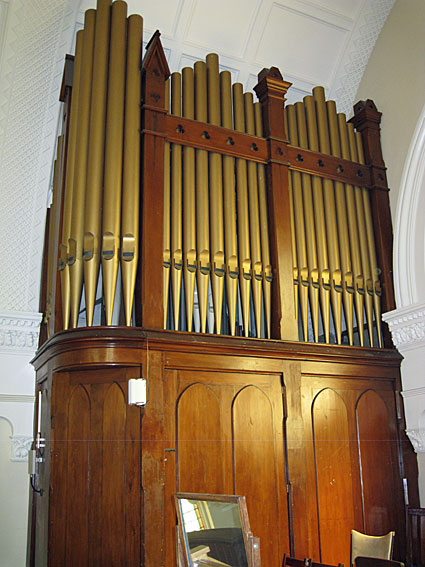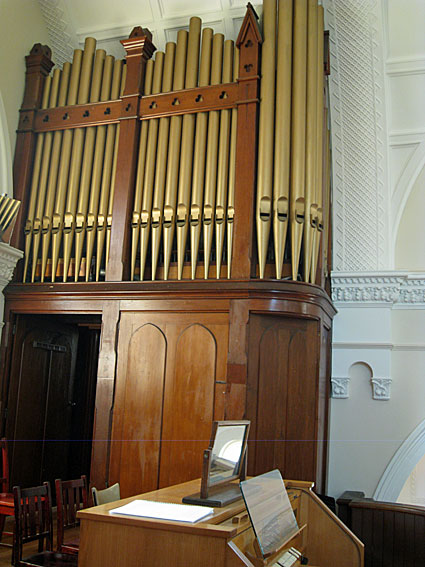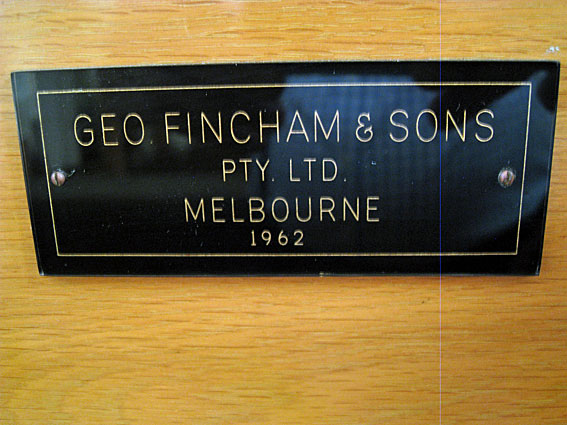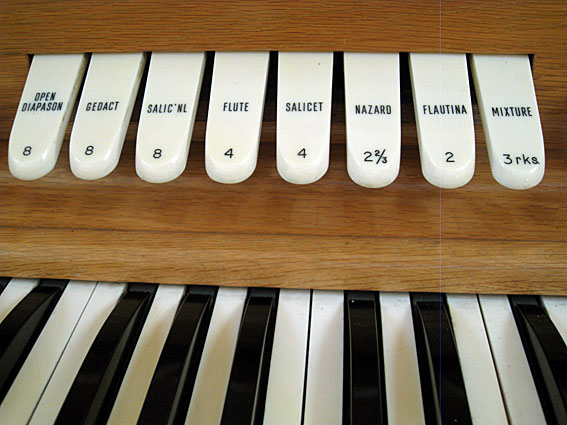
St John the Evangelist Catholic Church
(now part of the St Patrick's Cathedral parish), East Melbourne
[Photograph by Geoffrey Cox (February 2016)]

St John the Evangelist Catholic Church
(now part of the St Patrick's Cathedral parish), East Melbourne
[Photograph by Geoffrey Cox (February 2016)]
Historical and Technical Documentation by Geoffrey Cox
© OHTA 2016 (last updated March 2016)
The present St John's Catholic Church in East Melbourne, opened in 1930 by Archbishop Mannix, is the third of three churches erected on the site in succession, all of which are still standing. Designed by the architect W.P. Connolly in Romanesque revival style, it is constructed of brick with painted cement detailing, and incorporates a tall campanile and a barrel vaulted interior.1 The present church was built on the site of the original Holy Trinity Anglican Church, East Melbourne, the land having been sold to the Catholic Archdiocese of Melbourne in 1921.2 It is now part of the St Patrick's Cathedral parish.
The first and second St John's Churches, are still extant to the south of the present (third) church, and now form part of the Catholic Leadership Centre. The first church, by J.B. Denny, was built in 1865. The second church, designed by the architects McCrae and Toole in modified Romanesque style, was opened by Archbishop Carr on 21 April 1901. Its façade features a 34 feet high Celtic Cross carved from Stawell stone and including emblems of St John the Evangelist and St Patrick, to the right of which is an Irish Round Tower, believed to be a copy of the entrance to King Corman's Chapel on the Rock of Cashel in Tipperary, built in 1137.3


The second St John's Catholic Church, East Melbourne,
now the 'Celtic Hall' within the Catholic Leadership Centre.
[Photographs by Geoffrey Cox (February 2016)]
First Organ.
The first organ in the present (third) church derived from one that had been commenced in 1876-79 by Robert Mackenzie and completed by George Fincham of Melbourne in late 1879 - early 1880 for St Patrick's Cathedral, East Melbourne. There were additions to the organ by Fincham in 1886, and it was further enlarged to three manuals with additions by Fincham & Hobday of Melbourne in November 1896.

The Mackenzie / Fincham organ of 1880
at St Patrick's Cathedral, Melbourne
[The Australasian Sketcher (27 March 1880)]
The organ was broken up at the Cathedral in 1937. Much of the Swell and Great Organs were installed in reduced form at St John's Church in that year.4 The exact details of the resulting instrument at St John's instrument seem not to have been recorded, but it appears to have been a two-manual instrument with tubular-pneumatic action and around twenty speaking stops.
Paradoxically, much of this instrument, including the Great and Swell chests and most of the pipework, was removed from St John's around 1962, and incorporated into the organ built at St Patrick's Cathedral by George Fincham & Sons in 1964.5
The present casework at St John's (pictured below), which presumably dates from 1937, clearly derives from the Mackenzie/Fincham organ of 1880 at the Cathedral, reduced in scale for the smaller space. The case had been described in 1880 as being designed by "Mr Henderson",6 probably Anketell M. Henderson (1853-1922), who was later a partner in Reed, Henderson & Smart of Melbourne.7



The casework of the present organ
[Photographs by Geoffrey Cox (February 2016)]
Present Organ.
The present organ at St John's was built by George Fincham & Sons of Melbourne in 1962. It is an extension organ comprising 6 ranks and mixture, using unit chests and electro-pneumatic action.

The organbuilder's plate on the present organ
[Photograph by Geoffrey Cox (February 2016)]
The Swell is a standard Fincham extension organ of the period, partly duplexed to the Great and Pedal, while two of the three unenclosed ranks of the Great Organ (ranks A and C below) derive from the Mackenzie/Fincham organ installed in 1937.8
The console was moved to the nave of the church around 2000 by amateurs, but was restored to its original position in the gallery by Australian Pipe Organs of Keysborough in 2014.9


The Fincham console of 1962
[Photographs by Geoffrey Cox (February 2016)]
The building provides an excellent acoustic environment for the organ, which has the following specification:
| GREAT Contra Salicional Open Diapason Gedact Salicional Flute Principal Twelfth Fifteenth Mixture Trumpet Clarion SWELL Open Diapason Gedact Salicional Flute Salicet Nazard Flautina Mixture PEDAL Bourdon Principal Bass Flute 'Cello Quint Fifteenth Octave Flute COUPLER Great to Pedal |
16 8 8 8 4 4 2-2/3 2 III 8 4 8 8 8 4 4 2-2/3 2 III 16 8 8 8 5-1/3 4 4 |
F A E F E A B B G C C D E F E F E E G E A E F E A E |
[Ten.C] [unenclosed] [unenclosed] [unenclosed] [unenclosed] [unenclosed] [unenclosed] [gvd bass] [repeating] [bottom octave unenclosed] |
Detached stop-key console
[Swell] Tremulant
Full Organ stop-key
4 adjustable thumb pistons to Great Organ
4 adjustable thumb pistons to Swell Organ
4 adjustable thumb pistons to Pedal Organ
Great to Pedal reversible thumb piston
General Cancel thumb piston
Second touch cancellation to stop-keys
Balanced swell pedal (electro-pneumatic)
Electro-pneumatic action
Compass: 61/30.10



Pedal, Great and Swell stop-keys of the present organ
[Photographs by Geoffrey Cox (February 2016)]
1 Victorian Churches: Their origins, their story & their architecture, ed. Miles Lewis (Melbourne: National Trust of Australia (Vic), 1991), p. 52
2 http://www.cam.org.au/cathedral/History/Saint-John-the-Evangelist-East-Melbourne - accessed February 2016. See also: The Advocate (17 October 1929), p. 22.
3 Victorian Churches, p. 52; The Advocate (13 April 1901), p. 8.
4 Enid Matthews, Colonial Organs and Organbuilders (Carlton: Melbourne University Press, 1969), pp. 115, 131.
5 Matthews, p. 115.
6 The Advocate (13 March 1880), p. 7.
7 Susan M. Balderstone, 'Henderson, Anketell Matthew (1853–1922)', Australian Dictionary of Biography, National Centre of Biography, Australian National University, http://adb.anu.edu.au/biography/henderson-anketell-matthew-7060/text11405, published first in hardcopy 1983, accessed online 22 February 2016.
8 Personal communication to G. Cox from Robert Heatley, February 2016.
9 Personal Communication to G. Cox from Michelle Ehlers, Administration and House Manager, St Patrick's Cathedral, February 2016.
10 Specification noted by Geoffrey Cox, February 2016. Details of stop derivation and accessories noted by Robert Heatley, 1999.